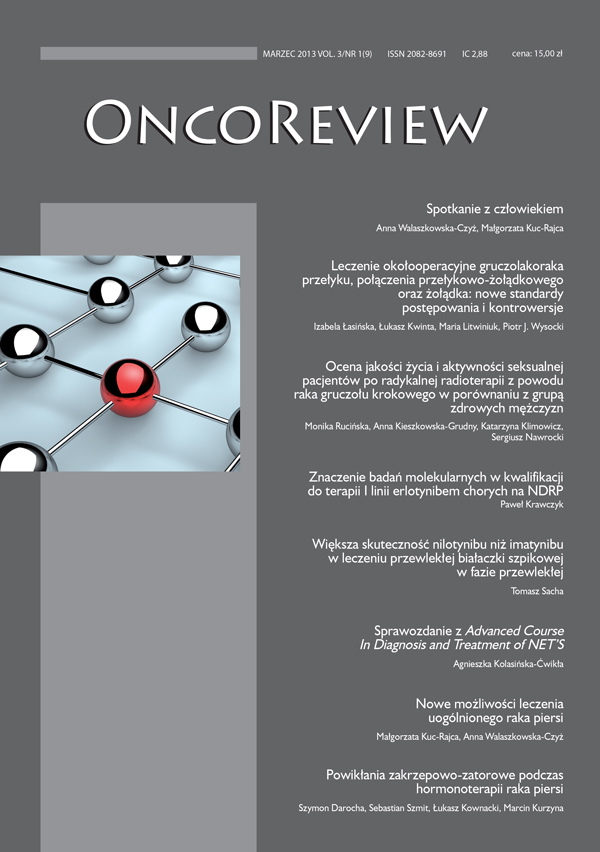Superior efficacy of nilotinib vs imatinib in patients with chronic myeloid leukemia in chronic phase. ENESTnd and ENESTcmr current results analysis Review article
Main Article Content
Abstract
Second generation tyrosine kinase inhibitors can improve the efficacy of treatment and outcome in newly diagnosed patients with chronic myeloid leukemia in chronic phase. The primary endpoint of ENESTnd trial is the comparison and assessment of major molecular response rate at 12 months in patients treated with nilotinib vs imatinib. With 4 years of follow-up, nilotinib demonstrate a superior efficacy over imatinib. In patients with CML-CP, early molecular response is associated with improved outcome. The reduction of bcr/abl level to ≤ 10% at 3 months correlated with significantly higher rates of deep molecular responses and significantly improved progression-free and overall survival. More patients achieved bcr/abl ≤ 10% and ≤ 1% at 3 months on frontline nilotinib vs imatinib. In ENESTcmr trial the percentage of patients with confirmed undetectable bcr/abl transcript or deep molecular response by 12 months achieved under nilotinib therapy in patients with complete cytogenetic response and detectable bcr/abl transcript after more than two-year treatment with imatinib has been evaluated. By 24 months, significantly more patients achieved confirmed undetectable bcr/abl and MR4,5 with switch to nilotinib. Increase in rate of undetectable bcr/abl transcript was 3 times higher on nilotinib vs imatinib from month 12 to 24. Deeper molecular responses after switch to nilotinib will probably create the possibility to participate in TKI-free remission studies for higher number of patients suffering from CML.
Downloads
Article Details

This work is licensed under a Creative Commons Attribution-NonCommercial 4.0 International License.
Copyright: © Medical Education sp. z o.o. This is an Open Access article distributed under the terms of the Attribution-NonCommercial 4.0 International (CC BY-NC 4.0). License (https://creativecommons.org/licenses/by-nc/4.0/), allowing third parties to copy and redistribute the material in any medium or format and to remix, transform, and build upon the material, provided the original work is properly cited and states its license.
Address reprint requests to: Medical Education, Marcin Kuźma (marcin.kuzma@mededu.pl)
References
2. Kantarjian H.M., Shah N.P., Cortes J.E. et al.: Nilotinib versus imatinib for the treatment of patients with newly diagnosed chronic phase, Philadelphia chromosome-positive, chronic myeloid leukaemia: 24-month minimum follow-up of the phase 3 randomised ENESTnd trial Lancet Oncol. 2011; 12: 841-851.
3. Larson R.A., Hochhaus A., Hughes T.P. et al.: Nilotinib vs imatinib in patients with newly diagnosed Philadelphia chromosome-positive chronic myeloid leukemia in chronic phase: ENESTnd 3-year follow-up. Leukemia 2012; 26: 2197-2203.
4. Marin D., Hedgley C., Clark R.E. et al.: Predictive value of early molecular response in patients with chronic myeloid leukemia treated with first-line dasatinib. J. Clin. Oncol. 2012; 30(3): 232-238.
5. Hanfstein B., Mueller M.C., Hehlmann R. et al.: Early molecular and cytogenetic response is predictive for long term progression-free and overall survival in chronic myeloid leukemia (CML). Leukemia 2012; 26: 2096-2102.
6. Hochhaus A., Hughes T.P., Saglio G. et al.: Outcome of Patients with Chronic Myeloid Leukemia in Chronic Phase (CML-CP) Based On Early Molecular Response and Factors Associated with Early Response: 4-Year Follow-up Data From Enestnd (Evaluating Nilotinib Efficacy and Safety in Clinical Trials Newly Diagnosed Patients). Blood 2012; 120(21): [streszczenie 0167].
7. Hughes T.P., Lipton J.H., Spector N. et al.: Switching to Nilotinib Is Associated With Continued Deeper Molecular Responses in CML-CP Patients With Minimal Residual Disease After ≥ 2 Years on Imatinib: ENESTcmr 2-Year Follow-up Results. Blood 2012; 120(21): [streszczenie 0694].

